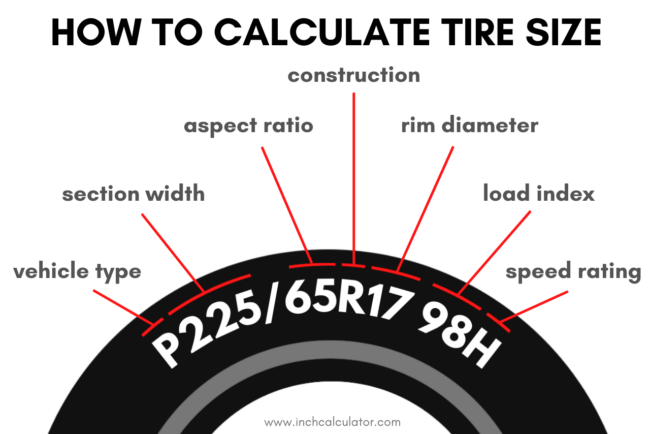Tire Size Comparison Calculator
Enter the sizes of two tires to calculate the diameter, circumference, sidewall, width, and revolutions per mile of each for a side-by-side comparison. Plus, see the amount of speedometer error for the new tire.
Tire Size Comparison:
| Tire One | Tire Two | Difference | |
|---|---|---|---|
| Diameter | |||
| Circum. | |||
| Width | |||
| Sidewall | |||
| Rev/Mile |
Speedometer Error
| Speedometer | Actual Speed |
|---|---|
| 30 mph | |
| 40 mph | |
| 50 mph | |
| 60 mph | |
| 70 mph | |
| 80 mph | |
| 90 mph |
How to Compare Tire Sizes
There are plenty of good reasons to change the size of your wheels and tires. Some drivers prefer to upgrade to larger or smaller wheels for a more individual look. This usually requires a change in tires as well. Other drivers may want to improve the functionality of their vehicles by switching to wider wheels and tires that provide more traction and grip.
Whatever the reason, when changing the wheels and/or tires on your vehicle to a new size, it’s important to compare the measurements and sizes of each of them to help determine if the new setup will work. You need to ensure that the new wheels/tires will fit the vehicle and look right. You also need to know whether your new wheels/tires will cause any speedometer error so that you can correct it if necessary.
The first step to comparing wheels and/or tires is to calculate the size of each tire, then compare their key dimensions.
The tire size comparison calculator above will generate all the dimensions of each wheel and/or tire in both inches and millimeters. It will also calculate the difference in each dimension between the wheels/tires to allow you to compare and see if the new set will work for your vehicle.
This tire size comparison calculator will also estimate the amount of speedometer error that will need to be accounted for when you change the size of your vehicle’s wheels and/or tires. The error for various speeds can be calculated in either miles per hour or kilometers per hour.
With this calculator, you can compare P-metric, euro-metric, LT, and flotation tire sizes.
When entering the sizes of the old and the new tires, there are three required values from the tire size as displayed on the tire’s sidewall. A tire size is usually stated like this: 225/65R17.
What Do the Letters and Numbers in a Tire Size Mean?
Every tire designed for a passenger vehicle comes with a standardized alphanumeric code that provides you with key information about that tire. Here’s what the letters and numbers in the tire size code mean:

Vehicle type: This first letter in the code tells you what type of vehicle the tire is intended to be used on. P means passenger car, LT means light truck, ST means special trailer, and T stands for temporary (as in a temporary spare tire that many vehicles use).
Section width: The section width is the first numerical value. It is located before the slash (“/”) and is measured in millimeters. This is the width of the tire from its inner sidewall to its outer sidewall, not including any protective ribs, raised letters, or other decorative elements.
Aspect ratio: The aspect ratio is the second numerical value and is located after the slash (“/”). This is the ratio between the section width of the tire (as described above) and the height of the tire itself. For example, if the tire has an aspect ratio of 65, it means that the height of the tire is 65% of its width.
Construction: This letter explains how the tire is constructed. R means radial ply (most passenger car tires are radials), D means diagonal ply, B means bias-belted, and the absence of a letter means that the tire is of cross-ply construction.
Rim Diameter: The rim or wheel diameter is the third numerical value. It is located after the R and is usually measured in inches. This is the size of the wheel that will fit the tire, and it is also the inside diameter of the tire.
Load Index: This is the last numerical value in the code and is expressed in either 2 or 3 digits. It normally ranges from 70 to 126. The load index number, when looked up in its table, lets you know the maximum weight that each tire can carry at a given inflation pressure.
Speed rating: This final letter in the tire sizing code tells you the highest sustained speed that the tire is capable of being run at, assuming that the tire is not damaged, is not overloaded, and is properly inflated.[1]
When changing the wheels and/or tires on a vehicle, it’s also important to ensure that the inner suspension clearance and outer fender clearance are adequate with the new wheels and/or tires. Try our wheel offset calculator to find the changes in inner and outer clearance with your new set of wheels and/or tires.
References
- Tire Rack, How Do I Check A Tire's Speed Rating?, https://www.tirerack.com/upgrade-garage/how-do-i-check-a-tire-s-speed-rating


